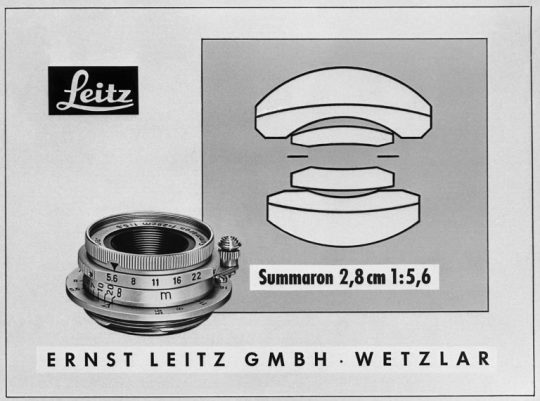#SUMMARON-M 28mm F5.6
Photo

Summaron 2,8cm 1:5,6
0 notes
Photo




2020/1/3
撮影地:西新宿
7 notes
·
View notes
Photo

“[...] if I am going anywhere interesting I take my camera along.”
—Elliott Erwitt
Leica
#travel#camera#photography#quote#elliott erwitt#leica#summaron 28mm F5.6#m system#vintage look#artisan & artist
4 notes
·
View notes
Photo

“Celebrity MILLENNIUM” to call at port of Yokohama,Japan
Camera : Leica M Monochrom + Summaron-M 28mm F5.6
1 note
·
View note
Text
「不自由だけど楽しいレンズ」その2ー Summaron-M 28mm /f5.6(復刻版)をX-Pro2とヘリコイドアダプターで
「不自由だけど楽しいレンズ」その2ー Summaron-M 28mm /f5.6(復刻版)をX-Pro2とヘリコイドアダプターで on Medium.
2 notes
·
View notes
Text
The Leica Summaron 28mm F5.6 is old-fashioned fun

The Leica Summaron-M 28mm F5.6 is a curious thing - a 'new' M-mount version of a pancake lens originally introduced in the mid 1950s. Manufactured in limited numbers between 1955-1963, the original Summaron would have been most commonly paired with Leica's screw-mount and (via adapters) M3 and M2 film rangefinders of the day.
So is the Summaron a collectors item best left inside its presentation box, or is this something you might actually want to shoot with?
Leica Summaron-M 28mm F5.6: Key specifications
Optical construction: 6 elements in 4 groups
Aperture range: F5.6-22 (full-stop detents)
Minimum focus: 3.3 feet (1m)
Filter thread: 34mm
Hood included
6-bit coded
Eight aperture blades
Weight: 165 g (0.36 lb)
Read more: https://www.dpreview.com/articles/3804675692/leicas-summaron-28mm-f5-6-is-old-fashioned-fun
24 notes
·
View notes
Video
Hatter's storefront by Shigeo MARUO
Via Flickr:
福岡市博多区 / LEICA M-P × Summaron 28mm F5.6 / / JG C3 03 025
2 notes
·
View notes
Text
Massive haul of Leica cameras and lenses stolen from Ffordes’ Scotland camera store
In the early hours of yesterday morning, thieves broke into the Ffordes Photographic Ltd camera shop in Inverness, Scotland. They took a huge amount of Leica cameras and lenses, and now the shop is appealing for help.
Ffordes initially took to Facebook to let people know what was going on and who to contact if they have any information. They have also now released an extensive list of all of the items that were stolen along with serial numbers.
Below is a complete list of all of the missing items, along with serial numbers. If you have any information regarding the break-in or the whereabouts of the equipment, please contact police on 01463 228452, quoting Police Incident Number: NN10337/18.
Digilux 3 + 14-50mm F2.8-3.5 3184940/4015515
Digilux 2 2991330
Leica X Series
X2 – Silver + Case + Finder Serial Number 4317553
Leica S/S2 Cameras
S Body Only (Typ 006) – Serial Number 4417070
S Body Only (Typ 006) – Serial Number 4686760
S Body Only (Typ 006) – Serial Number 4417295
S-E Body Only (Typ 006) – Serial Number 4810278
Leica S/S2 Lenses
30mm F2.8 Asph Elmarit S – Serial Number 4151485
120mm F2.5 Apo Macro Summarit S – Serial Number 4156132
120mm F2.5 Apo Macro Summarit S – Serial Number 4111860
120mm F2.5 Apo Macro Summarit S – Serial Number 4111659
Leica R Cameras
R8 Chrome Body Only – Serial Number 2285482
R8 Chrome Body Only – Serial Number 2291710
R8 Black Body Only – Serial Number 2775654
R7 Chrome Body Only – Serial Number 19999116
R6 Chrome Body Only – Serial Number 1776195
R4 Black Body Only – Serial Number 1608706
Leica R Lenses
75-200mm F4.5 R 3cam – Serial Number 2896362
2x Extender R – Serial Number 3326677
2x Extender R – Serial Number 3143272
Leica Q Series
Q (Typ 116) – Black – Serial Number 4932761
Leica SL Series
SL Typ 601 Body Only – Serial Number 4967157
SL Typ 601 Body Only – Serial Number 4993497
Leica V-Lux Series
Vlux 1 – Serial Number 3138988
Vlux – (Typ 114) – Serial Number 4860734
Leica T Series
TL2 Silver Body – Serial Number 5226072
TL Silver Body Only – Serial Number 5161802 / PA013849
T Black Body Only + PXC T to M Adapter – Serial Number 4815918 / 4266109
T Black Body Only – Serial Number 4821452
T Silver Body Only – Serial Number 4818007
T Black Body Only – Serial Number 4817778
T Silver Body Only – Serial Number 4812671
T Silver + 18-56mm Asph + Visoflex – Serial Number 4817415 / 4350298 / PA013854 / 18811
T Silver Body Only (Typ701) – Serial Number 4821089
55-135mm F3.5-5.6 APO-VArio-Elmar-T – Serial Number 4469344
60mm F2.8 Asph(Silver) Apo Macro TL + Hood 4629185
Leica Screw Cameras
IIIG Olive Green Body Only – Serial Number 956062
IIF R/Dial Chrome Body – Serial Number 809119
IIIF R/Dial D/A + 50mm F3.5 Red Scale – Serial Number 667839 / 1243798
IF Red Scale + 50mm F3.5 Red Scale – Serial Number 576302 / 1003317
IF Black Dial + 50mm F3.5 – Serial Number 807822 / 709025
IIIB Chrome + 50mm F2 – Serial Number 323656 /214313
IIIC Chrome Body – Serial Number 504790
III Chrome + 50mm F3.5 – Serial Number 216962 / 305349
Standard + 50mm F3.5 – Serial Number 65721
Model 1 C + 50mm F3.5 – Serial Number 42808
Leica Screw Lenses
28mm F5.6 Summaron – Serial Number 1557352
35mm F2.8 Summaron – Serial Number 19306022
50mm F2 Collapsible – Serial Number 1303973
50mm F2.8 Elmar – Serial Number 1494986
50mm F2.8 Elmar – Serial Number 1551423
85mm F2 – Serial Number 6401994
135mm F4.5 Hektor – Serial Number 1737254
Leica M Digital Cameras
M-P Chrome Body Only – Serial Number 4906950
M (240) Black Body Only – Serial Number 4808492
M (240) Black Body Only – Serial Number 4889524
M (240) Black Body Only – Serial Number 4800917
M (240) Black Body Only – Serial Number 4801374
M (240) Black Body Only – Serial Number 4699675
M (240) Black Body Only – Serial Number 4444688
M (240) Black Body Only – Serial Number 4823957
M (240) Black Body Only – Serial Number 4786077
M (240) Black Body Only – Serial Number 4852022
M (240) Chrome Body Only – Serial Number 4699650
M (240) Chrome Body Only – Serial Number 4788004
M (240) Chrome Body Only – Serial Number 4787257
M9 Black Body Only – Serial Number 3973678
Leica M Film Cameras
M7 0.72x Chrome Body Only – Serial Number 2777880
M7 0.72x Chrome Body Only – Serial Number 3999551
M4 M Black Body Only – Serial Number 1206858
M4 Chrome Body Only – Serial Number 1188908
M4 Black Chrome Body Only – Serial Number 1381876
M3 Chrome Body Only – Serial Number 752537
M2 Black Paint Body Only – Serial Number 976331
MDA Chrome Body Only – Serial Number 1361020
CL Body Only – Serial Number 1301127
CL + 40mm F2 – Serial Number 1023781 / 2123896
Leica M Digital Lenses
21mm F2.8 M Black + Finder – Serial Number 3194834
21mm F2.8 M Black – Serial Number 3425313
21mm F3.4 Chrome – Serial Number 2055088
21mm F4 Chrome – Serial Number 1672817
24mm F1.4 Asph M – Black – Serial Number 4158882
24mm F2.8 Asph M Black – Serial Number 3770009
24mm F2.8 Asph M Black – Serial Number 3809641
24mm F3.8 Asph M Black – Serial Number 4087819
24mm F3.8 Asph M Black – Serial Number 4082166
28mm F2 Asph M Black 6bit – Serial Number 4068297
28mm F2.8 M Black – Serial Number 3038060
28mm F2 Asph M Black 6bit – Serial Number 3900204
28mm F2 Asph M Black 6bit – Serial Number 4007609
28mm F2 Asph M Black 6bit – Serial Number 4191555
28mm F2 Asph M Black 6bit – Serial Number 4068297
Tri Elmar 28/35/50mm Cutaway
35mm F1.4 Black – Serial Number 2392558
35mm F1.4 M Titanium – Serial Number 3601491
35mm F2 Asph M Black – Serial Number 3888556
35mm F2 Asph M Black 6bit – Serial Number 3865574
35mm F2 Asph M Black 6bit – Serial Number 4210986
35mm F3.5 Chrome (M3)
50mm F0.95 Asph M – Black – Serial Number 4240749
50mm F1.1 Artisans 7 – Serial Number 651548
50mm F1.4 Asph M Black 6bit – Serial Number 4132394
50mm F2.8 M Black – Serial Number 3876484
50mm F2.8 Elmar – Serial Number 1728954
50mm F2 Rigid Chrome – Serial Number 1951149
50mm F2.5 M Black 6bit – Serial Number 4051037
50mm F2.8 Elmar – Serial Number 1591335
65mm F3.5 Elmar – Serial Number 2068148
75mm F2.5 M Black 6bit + Hood – Serial Number 4049065
75mm F2.4 M Black 6bit + Hood – Serial Number 4309490
75mm F2.5 M Black 6bit + Hood – Serial Number 4058073
90mm F2 Chrome – Serial Number 1818755
90mm F2 Chrome – Serial Number 1983754
90mm F2 Apo M Black – Serial Number 3923702
90mm F2.5 M Black 6bit – Serial Number 4195275
90mm F2.8 Black – Serial Number 2659101
90mm F2.8 M Black – Serial Number 3711244
90mm F2.8 M Black – Serial Number 3648550
90mm F2.8 M Black – Serial Number 3803578
90mm F2.8 M Black – Serial Number 3678222
90mm F2.8 Asph M Black 6bit – Serial Number 3992920
90mm F2.8 Chrome – Serial Number 1918017
90mm F2.8 Hexanon M Konica – Serial Number 3121555
90mm F4 Elmar – Serial Number 1712465
90mm F4 Chrome + OUAGO – Serial Number 1827197
90mm F4 C Elmar – Serial Number 2574963
90mm F4 C Elmar – Serial Number 2603256
90mm F4 C Elmar – Serial Number 2641782
135mm F2.8 Black – Serial Number 2325962
135mm F2.8 Black – Serial Number 2289332
135mm F2.8 Black – Serial Number 2621326
135mm F4.5 Chrome – Serial Number 1414042
135mm F4 Black – Serial Number 2106783
135mm F4 Black – Serial Number 2046698
135mm F4 Black – Serial Number 2083901
135mm F4 Black – Serial Number 2653434
200mm F4.5 Telyt – Serial Number 1503339
Billingham Shoulder Bag
335 – Black Fibre Nytex
The thieves obviously planned this well to be able to take such a large amount of equipment and they probably knew exactly what they were looking for.
If anybody offers you any cheap Leica equipment in the UK (and possibly elsewhere in the world over the coming weeks) or you see something for sale online, ask to see serial numbers and check against the list above or on the Ffordes Facebook page. And if there’s anything suspicious, please contact Inverness police on 01463 228452, quoting Police Incident Number: NN10337/18.
Ffordes Photographic Ltd opened for business in May 1960 in Basildon, Essex. The business was moved to Beauly in Scotland in 2001, twelve miles west of Inverness.
Source: https://bloghyped.com/massive-haul-of-leica-cameras-and-lenses-stolen-from-ffordes-scotland-camera-store/
0 notes
Text
The Leica Summaron 28mm F5.6 is old-fashioned fun
The Leica Summaron 28mm F5.6 is old-fashioned fun
The Leica Summaron-M 28mm F5.6 is a curious thing – a 'new' M-mount version of a pancake lens originally introduced in the mid 1950s. Manufactured in limited numbers between 1955-1963, the original Summaron would have been most commonly paired with Leica's screw-mount and (via adapters) M3 and M2 film rangefinders of the day. (more…)
View On WordPress
0 notes
Text
The Leica Summaron 28mm F5.6 is old-fashioned fun
The Leica Summaron-M 28mm F5.6 is a curious thing - a 'new' M-mount version of a pancake lens originally introduced in the mid 1950s. Manufactured in limited numbers between 1955-1963, the original Summaron would have been most commonly paired with Leica's screw-mount and (via adapters) M3 and M2 film rangefinders of the day.
So is the Summaron a collectors item best left inside its presentation box, or is this something you might actually want to shoot with?
Leica Summaron-M 28mm F5.6: Key specifications
Optical construction: 6 elements in 4 groups
Aperture range: F5.6-22 (full-stop detents)
Minimum focus: 3.3 feet (1m)
Filter thread: 34mm
Hood included
6-bit coded
Eight aperture blades
Weight: 165 g (0.36 lb)
The answer to that question is a bit complicated, and I must admit that I changed my mind a couple of times during the course of shooting for this article.
Initially, I must say I was rather skeptical. Leica lent me the Summaron ahead of a trip to Japan at the end of February, and I opted not to take it, borrowing a more practical 28mm F2.8 Elmarit instead. I enjoy vignetting as much as the next person, but I didn't like the idea of being limited to F5.6. The fact that the Summaron arrived in a satin-lined presentation box scared me a little, too. I'm painstakingly protective of loaner gear, but accidents do happen, and the thought of accidentally losing or scratching the tiny jewel-like lens worried me. So I took the Elmarit, and I don't regret it.
Back home though, with a few days left on the M10 loan agreement and a strong desire to get away from rain-drenched Seattle, I headed to the coast to see what the little Summaron could do.
Handling
There's not much I can say about the Summaron's handling, because there's precious little lens to actually handle. As you can hopefully tell from the photographs in this article, it's very small indeed, which means that focus and aperture rings are small, too. The focus ring features a traditional infinity lock, by way of a sprung peg that must be depressed to move the lens from its ∞ position.
Whether or not you get on with this depends partly on what you're used to. Personally I find the infinity lock a bit annoying, more so on this lens than others I've used with a similar design, mostly because the whole thing is so tiny. With the hood attached and the camera to my eye, there is very little tactile differentiation between the infinity release peg and the hood tightening peg. A bigger issue is that when rotating the focus ring, the one tends to get in the way of the other.
The Summaron's aperture ring is unusual by modern standards in that it has detents only at every full stop setting, not 1/2 or 1/3. You can of course live dangerously and set intermediate positions if you want to. The M10, at least, will recognize 1/2 steps in aperture-priority mode, but be warned - in its 1/2 stop positions, the 8-bladed aperture is far from rounded - in fact it's literally star-shaped.
Like the focus ring, the aperture ring is slim, and a little hard to find by touch when the hood is attached.
Given that the hood also occludes a decent portion of the M10's 0.72X viewfinder, I stopped using it pretty quickly, except when it was very obviously going to be necessary. Flare isn't enough of a risk to require it most of the time, and ditching the hood makes the Summaron's aperture and focus rings easier to manipulate.
Of course this is mitigated somewhat by the fact that when the lens is used at a small aperture and its corresponding hyperfocal focusing distance, there is very little need to actually adjust anything.
from DIYS http://ift.tt/2nWrYRw
0 notes
Photo




2020/1/11
撮影地:葛西臨海公園
4 notes
·
View notes
Text
The Leica Summaron 28mm F5.6 is old-fashioned fun
The Leica Summaron 28mm F5.6 is old-fashioned fun
The Leica Summaron-M 28mm F5.6 is a curious thing – a ‘new’ M-mount version of a pancake lens originally introduced in the mid 1950s. Manufactured in limited numbers between 1955-1963, the original Summaron would have been most commonly paired with Leica’s screw-mount and (via adapters) M3 and M2 film rangefinders of the day.
So is the Summaron a collectors item best left inside its…
View On WordPress
0 notes
Text
The Leica Summaron 28mm F5.6 is old-fashioned fun
The Leica Summaron-M 28mm F5.6 is a curious thing - a 'new' M-mount version of a pancake lens originally introduced in the mid 1950s. Manufactured in limited numbers between 1955-1963, the original Summaron would have been most commonly paired with Leica's screw-mount and (via adapters) M3 and M2 film rangefinders of the day.
So is the Summaron a collectors item best left inside its presentation box, or is this something you might actually want to shoot with?
Leica Summaron-M 28mm F5.6: Key specifications
Optical construction: 6 elements in 4 groups
Aperture range: F5.6-22 (full-stop detents)
Minimum focus: 3.3 feet (1m)
Filter thread: 34mm
Hood included
6-bit coded
Eight aperture blades
Weight: 165 g (0.36 lb)
The answer to that question is a bit complicated, and I must admit that I changed my mind a couple of times during the course of shooting for this article.
Initially, I must say I was rather skeptical. Leica lent me the Summaron ahead of a trip to Japan at the end of February, and I opted not to take it, borrowing a more practical 28mm F2.8 Elmarit instead. I enjoy vignetting as much as the next person, but I didn't like the idea of being limited to F5.6. The fact that the Summaron arrived in a satin-lined presentation box scared me a little, too. I'm painstakingly protective of loaner gear, but accidents do happen, and the thought of accidentally losing or scratching the tiny jewel-like lens worried me. So I took the Elmarit, and I don't regret it.
Back home though, with a few days left on the M10 loan agreement and a strong desire to get away from rain-drenched Seattle, I headed to the coast to see what the little Summaron could do.
Handling
There's not much I can say about the Summaron's handling, because there's precious little lens to actually handle. As you can hopefully tell from the photographs in this article, it's very small indeed, which means that focus and aperture rings are small, too. The focus ring features a traditional infinity lock, by way of a sprung peg that must be depressed to move the lens from its ∞ position.
Whether or not you get on with this depends partly on what you're used to. Personally I find the infinity lock a bit annoying, more so on this lens than others I've used with a similar design, mostly because the whole thing is so tiny. With the hood attached and the camera to my eye, there is very little tactile differentiation between the infinity release peg and the hood tightening peg. A bigger issue is that when rotating the focus ring, the one tends to get in the way of the other.
The Summaron's aperture ring is unusual by modern standards in that it has detents only at every full stop setting, not 1/2 or 1/3. You can of course live dangerously and set intermediate positions if you want to. The M10, at least, will recognize 1/2 steps in aperture-priority mode, but be warned - in its 1/2 stop positions, the 8-bladed aperture is far from rounded - in fact it's literally star-shaped.
Like the focus ring, the aperture ring is slim, and a little hard to find by touch when the hood is attached.
Given that the hood also occludes a decent portion of the M10's 0.72X viewfinder, I stopped using it pretty quickly, except when it was very obviously going to be necessary. Flare isn't enough of a risk to require it most of the time, and ditching the hood makes the Summaron's aperture and focus rings easier to manipulate.
Of course this is mitigated somewhat by the fact that when the lens is used at a small aperture and its corresponding hyperfocal focusing distance, there is very little need to actually adjust anything.
from DIYS http://ift.tt/2nWrYRw
0 notes
Photo

“Landmark Tower” Yokohama, JAPAN
Camera : Leica M Monochrom + Summaron-M 28mm F5.6
2 notes
·
View notes
Text
The Leica Summaron 28mm F5.6 is old-fashioned fun
The Leica Summaron-M 28mm F5.6 is a curious thing - a 'new' M-mount version of a pancake lens originally introduced in the mid 1950s. Manufactured in limited numbers between 1955-1963, the original Summaron would have been most commonly paired with Leica's screw-mount and (via adapters) M3 and M2 film rangefinders of the day.
So is the Summaron a collectors item best left inside its presentation box, or is this something you might actually want to shoot with?
Leica Summaron-M 28mm F5.6: Key specifications
Optical construction: 6 elements in 4 groups
Aperture range: F5.6-22 (full-stop detents)
Minimum focus: 3.3 feet (1m)
Filter thread: 34mm
Hood included
6-bit coded
Eight aperture blades
Weight: 165 g (0.36 lb)
The answer to that question is a bit complicated, and I must admit that I changed my mind a couple of times during the course of shooting for this article.
Initially, I must say I was rather skeptical. Leica lent me the Summaron ahead of a trip to Japan at the end of February, and I opted not to take it, borrowing a more practical 28mm F2.8 Elmarit instead. I enjoy vignetting as much as the next person, but I didn't like the idea of being limited to F5.6. The fact that the Summaron arrived in a satin-lined presentation box scared me a little, too. I'm painstakingly protective of loaner gear, but accidents do happen, and the thought of accidentally losing or scratching the tiny jewel-like lens worried me. So I took the Elmarit, and I don't regret it.
Back home though, with a few days left on the M10 loan agreement and a strong desire to get away from rain-drenched Seattle, I headed to the coast to see what the little Summaron could do.
Handling
There's not much I can say about the Summaron's handling, because there's precious little lens to actually handle. As you can hopefully tell from the photographs in this article, it's very small indeed, which means that focus and aperture rings are small, too. The focus ring features a traditional infinity lock, by way of a sprung peg that must be depressed to move the lens from its ∞ position.
Whether or not you get on with this depends partly on what you're used to. Personally I find the infinity lock a bit annoying, more so on this lens than others I've used with a similar design, mostly because the whole thing is so tiny. With the hood attached and the camera to my eye, there is very little tactile differentiation between the infinity release peg and the hood tightening peg. A bigger issue is that when rotating the focus ring, the one tends to get in the way of the other.
The Summaron's aperture ring is unusual by modern standards in that it has detents only at every full stop setting, not 1/2 or 1/3. You can of course live dangerously and set intermediate positions if you want to. The M10, at least, will recognize 1/2 steps in aperture-priority mode, but be warned - in its 1/2 stop positions, the 8-bladed aperture is far from rounded - in fact it's literally star-shaped.
Like the focus ring, the aperture ring is slim, and a little hard to find by touch when the hood is attached.
Given that the hood also occludes a decent portion of the M10's 0.72X viewfinder, I stopped using it pretty quickly, except when it was very obviously going to be necessary. Flare isn't enough of a risk to require it most of the time, and ditching the hood makes the Summaron's aperture and focus rings easier to manipulate.
Of course this is mitigated somewhat by the fact that when the lens is used at a small aperture and its corresponding hyperfocal focusing distance, there is very little need to actually adjust anything.
from DIYS http://ift.tt/2nWrYRw
0 notes
